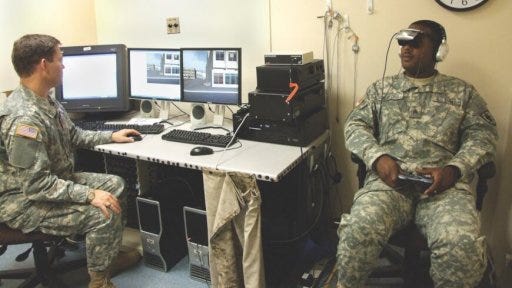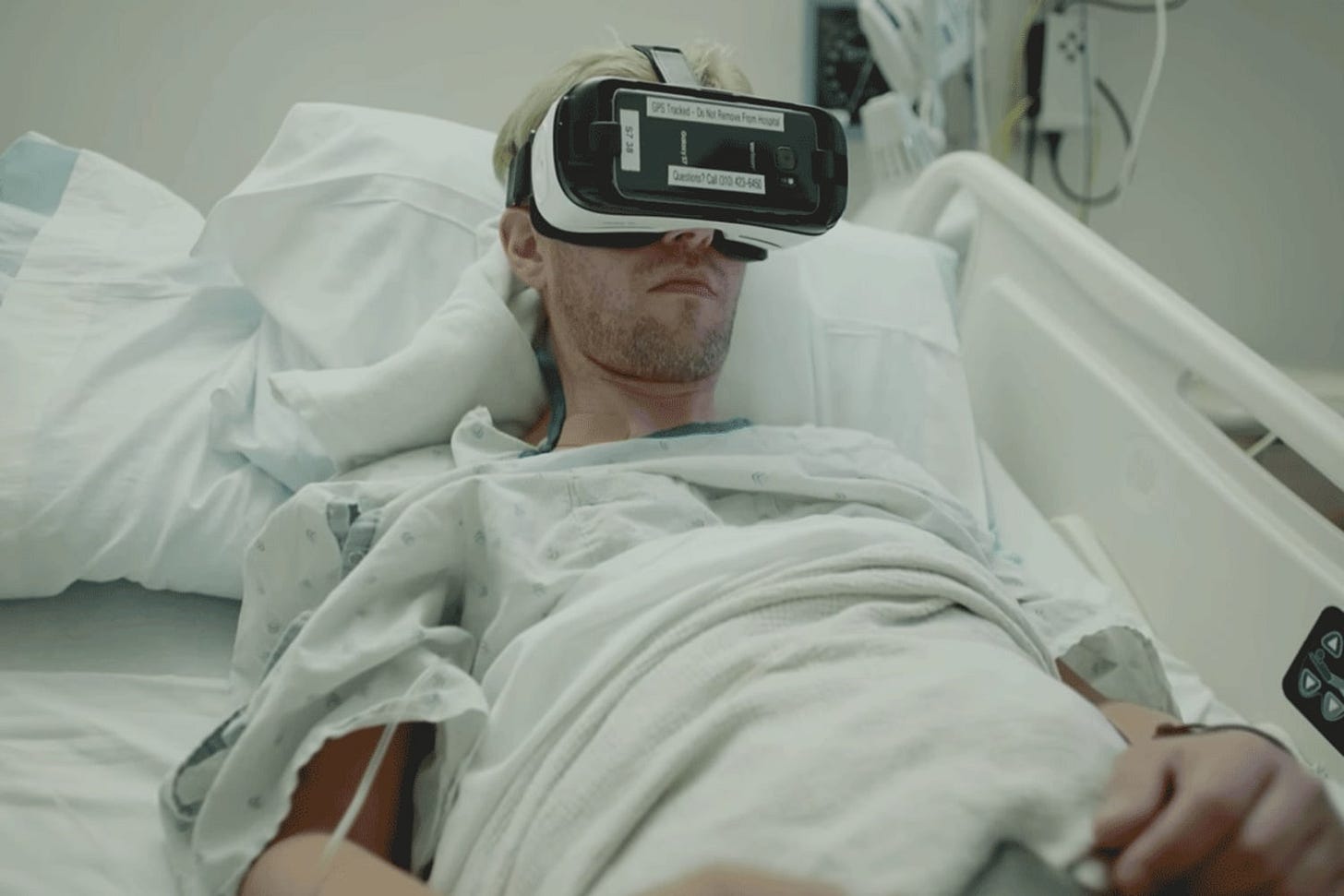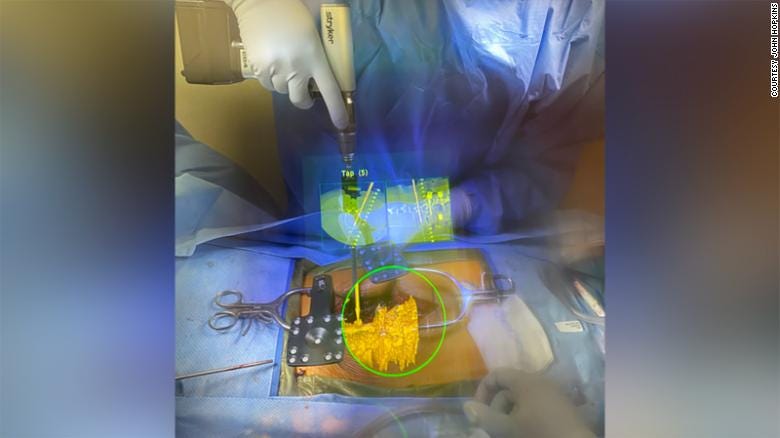How the metaverse will transform health
Vitamin Z is a newsletter about health and wellness. If you are new, you can join here.
Facebook last week announced it was renaming itself and investing $10 billion to build the metaverse.
It’s easy to dismiss Facebook’s—ahem, Meta’s—announcement as a slick PR move. People are wary of the company sinking its tentacles deeper into their personal lives. There are valid concerns about digital addiction and mental health.
I see the announcement a bit differently. The metaverse as a concept goes far beyond Facebook. It could usher in new possibilities for health and wellness.
A new generation of virtual health
I recently led a project for one of the world’s biggest tech companies. They’re developing a new system to bring interactive, social mixed-reality experiences into the home.
As I spoke to AR/VR developers and visual effects artists, I gained a new appreciation for this technology’s potential. The metaverse can be thought of as a 3D immersive environment shared by multiple users, in which you can interact with others via avatars.
People tend to think about the metaverse as VR, but it also encompasses AR (augmented reality), XR (extended reality) and MR (mixed reality, or merged reality).
Personally, I’m more excited about AR than VR. Why? VR cuts you off from the world around you. AR—technology that overlays interactive digital content on the real world—enhances the world around you.
How could the metaverse transform health and wellness? Unlike today’s virtual health tools, which can feel cumbersome, the next generation of virtual care will feel more like rich human interactions that recreate the in-person experience.
In this piece I’ll share six ways that AR, VR and MR are unlocking new approaches to healthcare—from mental health to pain management, surgery, fitness, physical therapy, telehealth and virtual patient care.
1. Mental Health
Doctors are prescribing VR games to treat conditions like brain fog, attention deficit hyperactivity disorder (ADHD), depression and post-traumatic stress disorder (PTSD).
A VR game called EndeavorRX by Akili Interactive in June 2020 became the first ever prescription-strength video game approved by the FDA to treat ADHD in children.
A company called Rey is using VR to treat social anxiety. Studies from Oxford University found that patients who used automated VR therapy experienced a 38% decrease in anxiety and avoidant symptoms over a six-week period.
Therapeutic VR is being used to treat veterans with PTSD. There’s an average of 20 U.S. military veteran suicides every day. In an effort to help combat this, VA hospitals across the country have begun offering a technology called BraveMind. The system, which delivers VR exposure therapy, has been shown to be an effective way to treat PTSD in veterans.
2. Pain management
Dr. Brennan Spiegel of Cedars-Sinai Medical Center has studied the use of VR to manage pain for hospitalized patients:
“Virtual reality is a mind-body treatment that is based in real science. It does more than just distract the mind from pain, but also helps to block pain signals from reaching the brain, offering a drug-free supplement to traditional pain management.”
Therapeutic VR is being used for burn victims at the University of Washington, pediatric patients at Children’s Hospital Los Angeles, and women in labor at Cedars-Sinai.
A research team from UCSF and AppliedVR found that providers treating Medicaid patients can integrate VR as an effective treatment for chronic pain. AppliedVR’s platform has been used by more than 30,000 patients in 240 health systems globally.
3. Surgery
Last June, a surgeon at John Hopkins in Baltimore, Maryland, conducted the first spinal neuro-navigation procedure guided by an AR headset called xvision by startup Augmedics.
Timothy Witham, M.D., director of the Johns Hopkins Neurosurgery Spinal Fusion Laboratory, said:
“When using augmented reality in the operating room, it’s like having a GPS navigator in front of your eyes in a natural way so you don’t have to look at a separate screen to see your patient’s CT scan.”
Neurosurgeons are using special AR microscopes that overlay critical information about brain structures on the surgical field. Technology called SyncAR shows a detailed visual of the specific body part that is being operated on, built using a patient's anatomical scans such as an MRI or a CT scan.
A company called AccuVein has invented an AR scanner that projects over skin and shows nurses and doctors where veins and valves are in a patient’s body. Such technologies can make medical procedures faster and more reliable.
4. Medical Training
Learning medicine often requires advanced visuospatial perception—whether it’s for assessing organ placement during surgery, or for understanding physiology at a cellular level. There are limitations to what you can learn from a textbook.
Mixed-reality (MR) medical training could be more effective in areas that require advanced hand skills. It could help guide use of surgical equipment. Using VR or AR in surgical procedure training allows the trainee to perform steps on a virtual patient or have patient information superimposed with reality.
A study showed the use of VR simulators helped in diagnostic and surgical procedures, improving novice hospital residents’ laparoscopic skills in terms of error and procedure time reduction.
I spoke with an executive at GigXR, a company developing mixed reality healthcare applications for clinical training and education. He said: “Our immersive simulations enable collaborative group learning and better outcomes for both learners and patients.” They’ve licensed their system to medical and nursing schools and the Department of Defense.
These tools could expand access to top-quality medical education and care. Students and patients in low-income areas could have access to resources from the best institutions in the world, via immersive virtual experiences.
5. Virtual fitness
More people are supplementing their gym routine with VR-based exercise. Meta last week announced it was acquiring VR fitness subscription service Supernatural. The startup is like Peloton for at-home VR training sessions.
VR could be “your new physical therapist,” the New York Times wrote in April. A study of patients recovering from stroke or spinal-cord injury found VR exercise has the potential to improve rehabilitative outcomes compared with traditional exercise.
A company called XRHealth provides VR physical and occupational therapy at home, and is covered nationally by Medicare.
One benefit of VR therapy is that it can provide specific data to the clinician and patient on how often and how well the patient accomplished each exercise and where adjustments are needed. Gamification of these VR tools can make monotonous rehab experiences fun, enjoyable, repeatable, and therefore more sustainable with longer-term benefits.
There have been studies on AR’s potential to enhance post-stroke rehabilitation. The technology can shorten recovery times by making it easier for patients to do their exercises at home.
One challenge for healthcare systems is keeping patients engaged in their recovery once they’re out of the hospital. Home-based AR systems could transform how doctors manage chronic conditions like diabetes, tying into wearable blood-glucose monitors and providing interactive recommendations for patients in their daily lives.
6. Telehealth and virtual patient communities
While Covid has accelerated the growth of telehealth, current solutions are limited. They don’t recreate the intimacy of the in-person patient experience.
The metaverse may enhance telehealth solutions, bridging the distance between patients and providers. It can elevate virtual care from a 2D to a 3D experience, changing the way patients interact with healthcare providers in a fundamental way.
Virtual patient communities could become more fun and engaging with AR and VR. We may see the rise of virtual spaces specific to chronic conditions like Parkinson’s and diabetes. Patients, providers and caregivers would be able to connect in more intimate, natural ways—even if they’re separated by thousands of miles.
There will be challenges to realizing the potential of the health metaverse: technical (interoperability, portability), human factors (skills, resistance, mistrust), legislative and regulatory.
The technology underlying the health metaverse is still a few years away. But we’re already seeing examples of how VR and AR can make a difference in health and wellness. I’m excited to see how this technology enables new solutions for patient access and improved care.
In the words of one VR futurist:
“The world is about to be painted with data. The canvas is as broad as the physical world, and blank as a fresh sheet of paper.”
Until next week,
By Daniel Zahler
Hi there! Thanks for reading. If you stumble on my newsletter, you will notice that I write about health and wellness trends, and strategies & tactics on how to optimize cognitive, physical and emotional health. I hold a JD and BA from Harvard, have worked at Goldman Sachs and McKinsey, and serve as a GLG council member advising global business leaders on healthcare innovation.
Check out my articles in Thrive Global here.
Enjoy this?
There are a few things to do:
Follow me on Twitter.
Hit reply with your feedback and ideas :)
Share this post with others.









